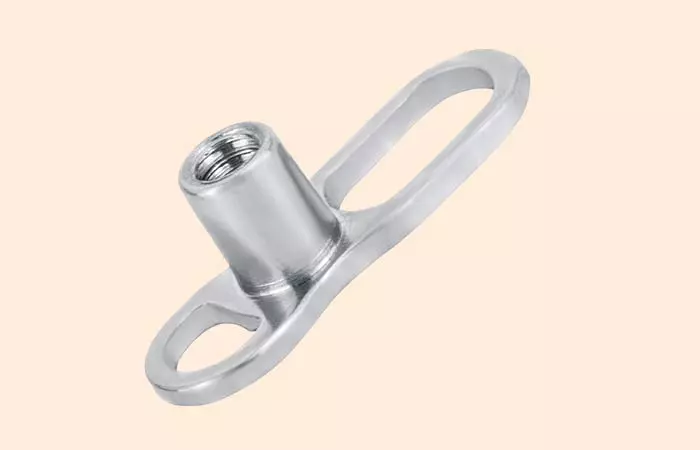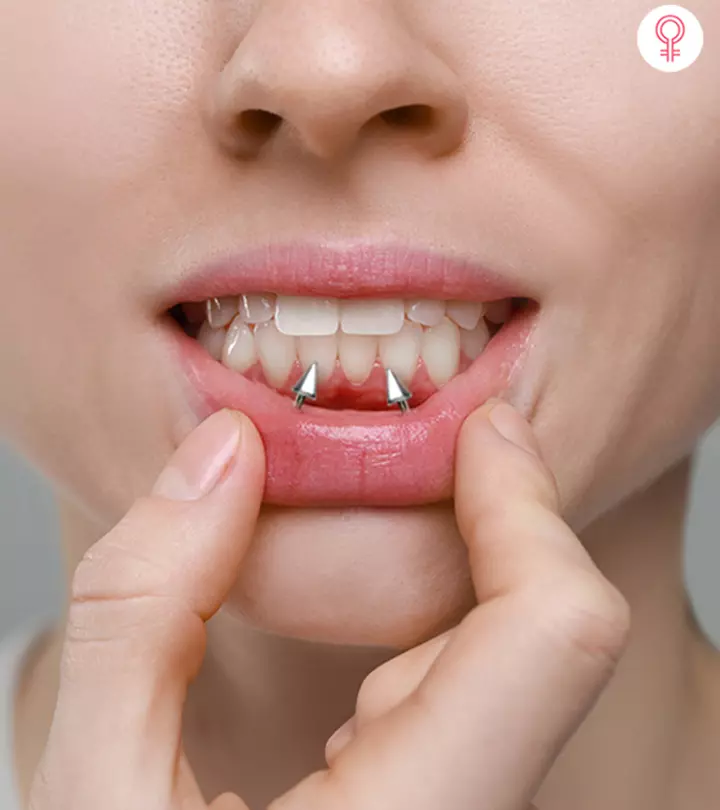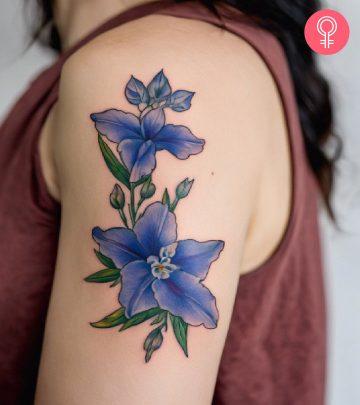Hip Piercing: Types, Pain, Healing, Jewelry, And Cost
Stand out in the crowd and express your individuality with this unique and bold piercing!

Image: StyleCraze Design Team
Are you looking to add some personality to your style? Then hip piercings can be a really cool way to do just that! These are perforations near the hip area or the hip bone that are aesthetic yet subtle. However, getting one may not always be a walk in the park. It is important you are aware of the different types of piercings available, the possible pain, the healing time, and the kinds of jewelry you can wear. In this article, we have discussed it all. Continue reading and get ready to rock hip jewelry.

 Piercing Guide: Hip Piercing
Piercing Guide: Hip Piercing- Placement: Hip area
- Best Jewelry: Surface bars or curved barbells
- Cost: $50 to $100
- Pain Level: Medium
- Healing Time: 6 to 12 months
In This Article
Types Of Hip Piercings
Hip piercing is a type of body modification where jewelry is inserted through the skin on the hip area, accentuating the contours of the hip bone. This type of piercing is popular and daring, usually done using surface bars or dermal anchors. Here are some of the hip piercing options to consider:
1. Surface Hip Piercing
View this post on Instagram
Surface hip piercings involve placing jewelry on the surface of the skin without going through the hip bone. A skilled piercer uses a needle to create an entry and exit point, threading jewelry along the surface. Due to the body’s constant movement, surface piercings have a higher risk of rejection or migration compared to other types.
2. Dermal Hip Piercing

Dermal hip piercings, also known as single-point or anchor piercings, utilize a flat base with a visible top. The piercer makes a small incision, inserts the anchor under the skin, and secures it with the jewelry protruding. This type provides a sleek look with reduced jewelry visibility compared to surface piercings.
3. Microdermal Hip Piercing

Microdermal hip piercings involve placing a small, anchor-like base beneath the skin, and a single decorative top is visible on the surface. Unlike dermal piercings, these anchors can be removed without cutting, making jewelry changes easier. This method offers flexibility and less trauma to the surrounding tissue.
These popular piercings can be a bold and stylish choice! When it comes to jewelry and materials, it is essential to prioritize both aesthetics and biocompatibility. Scroll down to learn more about them!
Key Takeaways
- There are three types of hip piercings – surface hip piercing, dermal hip piercing, and microdermal hip piercing.
- Hip piercings give jewelry options, ensuring a stylish and comfortable statement.
- Protect your hip piercing from infections by cleaning it with a mild saline solution, antibacterial soap, and clean materials.
- There might be risks like jewelry rejection, migration, allergic reactions and even nerve damage, so keep an eye out for any odd change during the healing process.
Hip Piercing Jewelry And Material

Hip piercings have gained popularity in recent years, offering a unique and stylish way to express oneself. When it comes to hip piercing jewelry and materials, there are various options to choose from.
Jewelry
1. Surface Bars

These are commonly used for hip piercings due to their stability and low chance of rejection. They have a straight bar with two visible ends, allowing for a secure and comfortable fit.
2. Curved Barbells

Another popular choice, especially for initial piercings. They come in various materials and designs, offering versatility in style.
 Did You Know?
Did You Know?3. Dermal Anchors

These are single-point piercings that sit flush against the skin, providing a sleek and minimalistic look.
Materials
1. Surgical Stainless Steel:
A common and affordable option, known for its durability and resistance to corrosion. It is an excellent choice for initial piercings.
2. Titanium: Hypoallergenic and lightweight, making it suitable for those with sensitive skin. Titanium also comes in various vibrant colors, adding a personalized touch to your hip piercing.
3. Niobium: Another hypoallergenic option, similar to titanium. It is known for its unique anodized color options, providing a wide range of choices.
4. Gold: A classic and elegant choice. Make sure to choose high-quality gold (14KT or 18KT) to avoid allergic reactions.
5. Bioplast: A flexible and biocompatible material that reduces the risk of irritation. It is a good option for those with metal allergies.
Maintaining proper hygiene for your hip piercing is essential to ensure a swift and complication-free healing process. Take a look at the cleaning routine that will not only promote healing but also keep your piercing looking and feeling its best.
How To Clean A Hip Piercing

Keeping a hip piercing clean is crucial to prevent infection and promote healing. Here is a simple guide:
What You Need
- Mild saline solution: You can either buy a pre-made saline solution or make your own by dissolving ¼ teaspoon of non-iodized sea salt in 8 ounces of warm distilled water.
Clean, disposable paper towels or cotton balls - Antibacterial soap
- Clean, disposable gloves
- A clean, soft cloth or gauze
What To Do
- Start with clean hands to avoid introducing bacteria to the piercing.
- If you are making it yourself, ensure the salt is completely dissolved in warm distilled water.
- Gently clean the piercing and the surrounding area using a mild, fragrance-free antibacterial soap.
- Rinse thoroughly to remove any soap residue.
- Soak a clean cotton ball or disposable paper towel in the saline solution. Gently press it against the piercing, allowing the solution to penetrate and cleanse the area. Hold for a few minutes.
- If your piercing involves a movable piece of jewelry, gently rotate it during the saline soak.
- Use a clean, soft cloth or gauze to pat the area dry.
- If possible, allow the piercing to air dry for a few minutes. This helps prevent irritation.
 Quick Tip
Quick TipNavigating the aftercare journey for your hip piercing is crucial for a seamless healing experience. With the right attention and gentle care, you can flaunt your stylish hip piercing while minimizing any potential discomfort or complications. Check out the next section to know more.
Hip Piercings Aftercare

Taking care of a hip piercing is crucial to ensure it heals properly and stays infection-free. Here are some general aftercare tips:
- Clean the area twice a day with saline solution to prevent infection.
- Avoid touching or twisting the piercing to promote complete healing.
- Wear loose clothing to minimize friction and irritation.
- Avoid fabrics that might snag on the piercing accidentally.
- Choose breathable fabrics to allow proper airflow and minimize moisture.
- Limit exposure to pools, hot tubs, and other bodies of water to prevent bacterial exposure.
- Avoid excessive sun exposure and apply sunscreen if advised by your piercer to protect healing piercings.
- Embrace a balanced diet and stay hydrated to promote overall healing.
- Refrain from changing the jewelry too soon to allow the piercing to establish itself.
- Apply a non-alcoholic, non-iodized sea salt compress for additional soothing and cleansing.
- Attend follow-up appointments with your piercer for professional guidance and assessment.
Embarking on the path of hip piercings involves understanding the nuanced interplay between pain and the healing journey. In the next section, find out all about its pain and the healing process.
Hip Piercing Pain And Healing Guide
View this post on Instagram
Hip piercings may involve moderate pain during the procedure. Healing time typically spans 6-12 months, with initial soreness, redness, and swelling. Individual pain tolerance varies. Be cautious with movement and avoid tight clothing during the healing process. Consulting a professional piercer for guidance is recommended.
Alyssa Renee, a YouTuber, talks about her personal experience with hip piercings. In her video, she said, “I was in a lot of pain obviously, a curse that’s how bad it hurt.” She also added, “I was breathing really hard and especially after I was like relieved that it was all over but I believe it was like a seven point five or eight on a scale from one to ten (i).”
Now, find out the potential side effects that may arise. Understanding and addressing these effects ensures a stylish journey that prioritizes both aesthetics and well-being.
Side Effects Of Hip Piercings

Hip piercings, like any other body piercings, come with potential side effects. Here are some common ones:
- Pain and swelling are common initially but should subside.
- Infections can occur without proper aftercare, with signs like redness and discharge.
- Allergic reactions may happen, especially if the jewelry contains metals like nickel (1).
- Rejection or migration can occur as the body tries to push out the foreign object.
- Scarring is a natural part of healing, but excessive scarring can happen with poor care.
- Bruising may occur, particularly if the piercing process causes trauma to the tissue.
- Nerve damage is a rare but possible side effect, leading to numbness or altered sensation.
Explore the budgetary considerations in the following section to make a well-informed decision and stylishly enhance your hips.
How Much Do Hip Piercings Cost
View this post on Instagram
The cost of a hip piercing can vary depending on factors like the piercing studio’s location, reputation, and the type of jewelry you choose. Also, along with the reputation of the studio if you go to a reputable piercer, that too, can affect the price. On average, you can expect to pay anywhere from $50 to $100 for the piercing itself. Keep in mind that this doesn’t include the cost of the jewelry, which can range from $10 to $50 or more, depending on the material and design.
Elevate your style with the bold and trendy world of hip piercings. Surface, dermal, or microdermal – choose your style and express yourself. Explore the variety of jewelry options, from surface bars to curved barbells, and choose one that goes with your vibe. Maintaining your piercing’s hygiene is paramount; a gentle cleaning routine with saline solution keeps your hip piercing infection-free and promotes swift healing. Embrace aftercare practices, opting for loose clothing and breathable fabrics. Navigating potential side effects like severe pain and swelling is part of the journey, but with proper care, the stylish outcome is worth it. Consider the financial aspect, with an average cost of $50 to $100 for the piercing and additional expenses for unique jewelry. Make informed decisions, and rock your hip piercing with confidence.
Frequently Asked Questions
How to change out a hip piercing?
To change out a hip piercing, wash your hands thoroughly, gently unscrew the ends of the jewelry, and carefully slide out the old jewelry before inserting the new one. Clean the area with a saline solution and ensure both the jewelry and hands are sanitized to minimize the risk of infection during the process.
How long do hip dermals last?
Hip dermals, also known as surface anchors, can last anywhere from a few months to several years, depending on factors like jewelry quality, aftercare, and individual body response. Regular check-ups with a professional piercer and proper care can help extend the lifespan of hip dermals.
Can you get a hip piercing at the age of 14?
The legal age for getting a hip piercing varies by location, but many reputable piercing studios require individuals to be at least 16 years old and have parental consent. Always check local regulations and consult with a professional piercer who follows age-appropriate guidelines.
Are you prepared to accept a novel way to express yourself? Then get to know the entire process of getting a hip dermal piercing in this video. Hit the play button now and get inspired!
Personal Experience: Source
StyleCraze's articles are interwoven with authentic personal narratives that provide depth and resonance to our content. Below are the sources of the personal accounts referenced in this article.
(i) All about MY hip piercings + Live Piercing cliphttps://www.youtube.com/watch?v=1eiF5S7CFiI
References
Articles on StyleCraze are backed by verified information from peer-reviewed and academic research papers, reputed organizations, research institutions, and medical associations to ensure accuracy and relevance. Read our editorial policy to learn more.
- Management of contact dermatitis due to nickel allergy an update
https://www.ncbi.nlm.nih.gov/pmc/articles/PMC3047925/
Read full bio of Anastasiia Gatsko
Read full bio of Pahul Nanra
Read full bio of Asmita De
Read full bio of Shreya Mukherjee


























Community Experiences
Join the conversation and become a part of our empowering community! Share your stories, experiences, and insights to connect with other beauty, lifestyle, and health enthusiasts.